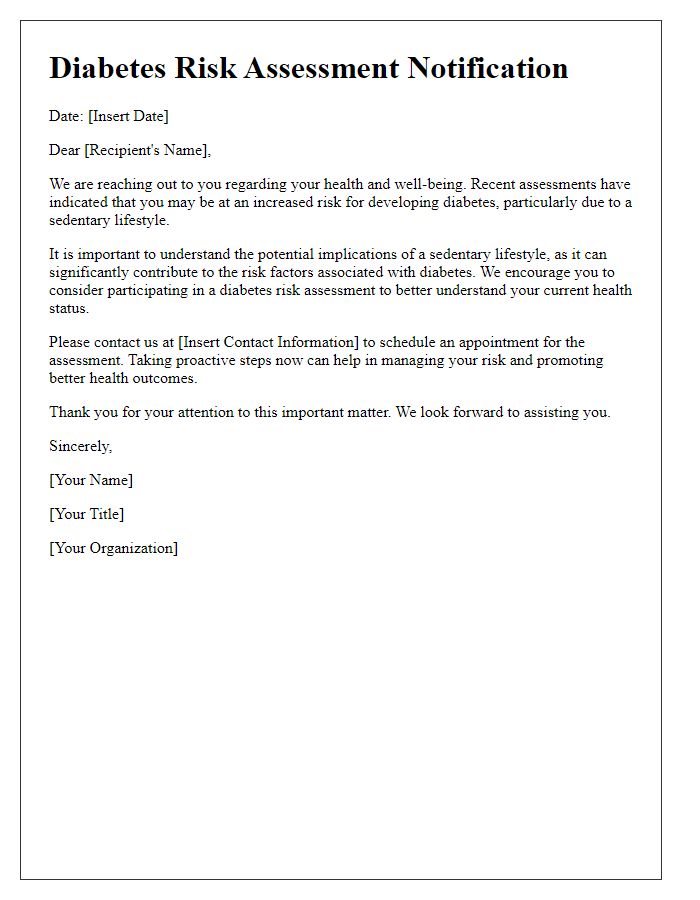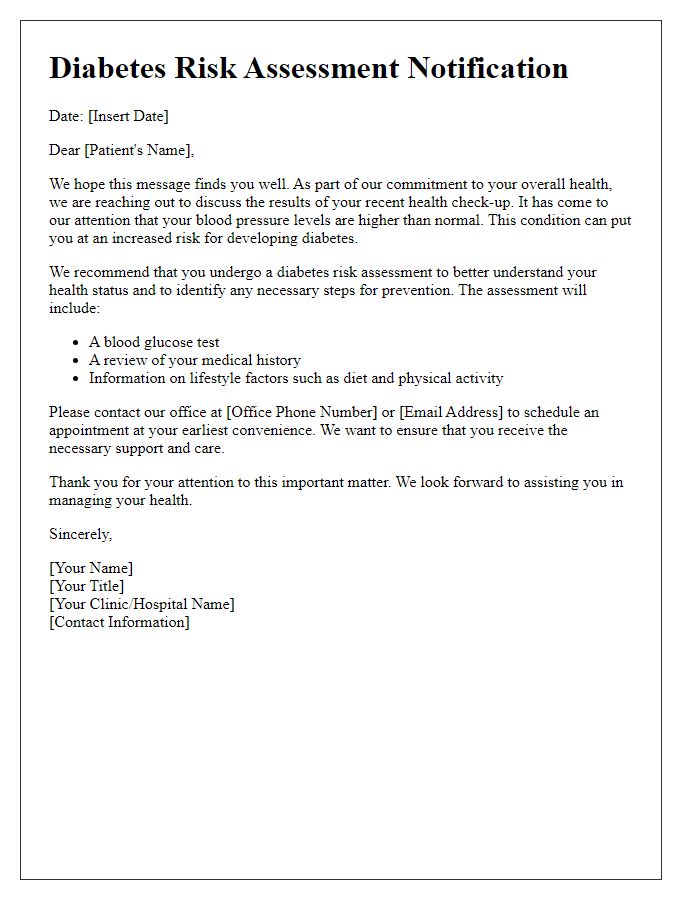Are you concerned about the rising trend of diabetes and how it might affect you or your loved ones? Understanding your risk factor through a diabetes risk assessment can empower you to make informed lifestyle choices. With early detection and proper management, you can significantly lower your chances of developing this chronic condition. Curious to learn more about how to assess your risk and take proactive steps? Keep reading!

Personal Information
Personal information plays a crucial role in diabetes risk assessment, highlighting essential details such as age, weight, height, and family history of diabetes. Age, particularly over 45 years, is a significant risk factor for type 2 diabetes, as the likelihood increases with each passing decade. Body mass index (BMI), calculated from weight and height, provides insight into obesity, a critical risk factor linked to insulin resistance and impaired glucose metabolism. Furthermore, a family history of diabetes, particularly in first-degree relatives, elevates one's odds due to genetic predispositions. Additionally, nationality and ethnicity have been documented, with individuals of African American, Hispanic, and Native American backgrounds exhibiting higher susceptibility to diabetes. Collectively, this personal information guides healthcare professionals in assessing individual risk levels and tailoring prevention strategies effectively.
Medical History
Diabetes risk assessment involves analyzing medical history for relevant factors. Family history of diabetes significantly increases risk, especially in immediate relatives such as parents or siblings. Personal medical history should include previous diagnoses of related conditions like hypertension or polycystic ovary syndrome, both of which correlate with higher diabetes risk. Age is also a crucial factor; individuals over 45 years old face increased susceptibility. Additionally, body mass index (BMI) plays a significant role; a BMI over 25 indicates overweight status, heightening diabetes risk. Lifestyle factors including sedentary behavior and dietary patterns, particularly high sugar and fat intake, further contribute to the assessment. Awareness of these elements helps in creating comprehensive risk profiles for effective diabetes prevention strategies.
Lifestyle Factors
Regular physical activity plays a significant role in managing diabetes risk factors, with the American Diabetes Association recommending at least 150 minutes of moderate aerobic exercise each week, such as brisk walking or swimming. Diet choices, including consumption of whole grains, fruits, and vegetables, can also influence glucose levels and insulin sensitivity. Maintaining a healthy weight is essential; research indicates that even a 5-10% reduction in body weight can lower the risk of developing type 2 diabetes. Additionally, avoiding tobacco products (notably cigarettes) and limiting alcohol intake is crucial since smoking can increase insulin resistance and excessive alcohol can lead to fluctuations in blood sugar levels. Mental health factors, including stress and depression, can complicate diabetes management, thus mindfulness practices may enhance long-term health outcomes. Regular screenings at healthcare facilities, like annual fasting blood sugar tests, are vital for early detection and intervention.
Family History
Family history plays a crucial role in assessing the risk of developing diabetes, particularly Type 2 diabetes, which accounts for nearly 90-95% of all diabetes cases globally. Individuals with a first-degree relative, such as a parent or sibling, diagnosed with diabetes exhibit a significantly higher likelihood of developing the condition themselves, with risk estimates ranging from 20% to 40%. Genetic factors, alongside lifestyle influences heightened by familial habits, converge to shape this increased susceptibility. Moreover, specific ethnic backgrounds, such as African American, Hispanic, and Native American populations, experience compounded risk due to both genetic disposition and socioeconomic determinants. Early screening and intervention are vital for those with a family history of diabetes, ensuring proactive management of blood glucose levels and overall health.
Assessment Results
Diabetes risk assessments are crucial in identifying individuals predisposed to developing Type 2 diabetes, a chronic condition affecting glucose metabolism. Common risk factors include obesity (with a Body Mass Index exceeding 30), sedentary lifestyle, family history of diabetes, and age (individuals over 45 years are at increased risk). The American Diabetes Association recommends screening using the American Diabetes Risk Test, which evaluates factors such as age, weight, activity level, and family history. Elevated blood sugar levels (greater than 126 mg/dL during fasting tests) can indicate prediabetes, a condition affecting approximately 88 million adults in the United States. Identifying and addressing these risks early can significantly influence an individual's health trajectory, potentially preventing the onset of diabetes-related complications such as cardiovascular disease and kidney dysfunction. Continuous monitoring and lifestyle modifications, including nutrition management and regular physical activity, can enhance overall well-being and reduce diabetes risk.
Letter Template For Diabetes Risk Assessment Samples
Letter template of diabetes risk assessment for individuals with family history.

Letter template of diabetes risk assessment for women with gestational diabetes.

Letter template of diabetes risk assessment for individuals with sedentary lifestyles.

Letter template of diabetes risk assessment for patients with high blood pressure.

Letter template of diabetes risk assessment for those experiencing symptoms.

Letter template of diabetes risk assessment for community health evaluations.








Comments